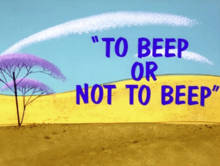To Beep or Not to Beep
To Beep or Not to Beep is a 1963 Warner Bros. Merrie Melodies animated short directed by Jones. (Maurice Noble received credit as co-director.)[1] The short was released on December 28, 1963, and stars Wile E. Coyote and the Road Runner.[2]
| To Beep or Not to Beep | |
|---|---|
 | |
| Directed by | Chuck Jones Maurice Noble Tom Ray |
| Produced by | David H. DePatie John W. Burton Edward Selzer |
| Story by | John Dunn Chuck Jones Michael Maltese |
| Starring | Paul Julian Mel Blanc |
| Music by | Bill Lava |
| Animation by | Richard Thompson Bob Bransford Ben Washam Tom Ray Ken Harris Harry Love |
| Layouts by | Maurice Noble Ernie Nordli |
| Backgrounds by | Philip DeGuard |
| Color process | Technicolor |
Production company | |
| Distributed by | Warner Bros. Pictures |
Release date | December 28, 1963 (U.S.) |
Running time | 6:38 |
| Language | English |
The short was originally produced as part of a 1962 pilot for a television series, Adventures of the Road Runner. After the pilot was not picked up, it was split into three shorts and released theatrically. The other two shorts were Road Runner a Go-Go and Zip Zip Hooray! [3]
In a 2005 interview Jones notes that, in the final series, the Road Runner only appears briefly.[4]
Plot

The opening scene shows Wile E. Coyote reading a "Western Cookery" recipe book in total peace. Completely unaware that his prey has zoomed up behind him to sneak a peek at his book, he slurps at the prospect, then finds himself nose-to-beak with the Road Runner. Enraged by the bird, the coyote tries a number of strategies to catch the creature. He tries a lasso, and ends up hit by a rock; he tries chasing the bird at supersonic speed and falls off a bridge and a cactus falls on him; he tries shooting himself toward the bird with a giant spring; and he tries to drop a wrecking ball on the Road Runner with a crane. Finally, he attempts to flatten the Road Runner with a boulder hurled by a catapult. Unfortunately for Wile E., the catapult finds multiple ways to malfunction, resulting in the Coyote getting pancaked each time. The camera zooms in towards the manufacturer's nameplate and reveals that the catapult had been built, not by ACME, but by the "Road-Runner Manufacturing Company — Phoenix * Taos * Santa Fe * Flagstaff." The Road Runner on the nameplate then comes to life, gives the audience a "Beep-Beep" and then zooms off.
Legacy
Murat Öğütcü listed "To Beep or Not to Beep" in an article on cartoons that relied on Shakespearean puns.[5]
Victor Kennedy noted in, "The Gravity of Cartoon Physics; or, Schrödinger’s Coyote", the strange "concertinafication", Coyote experienced, when aliding with walls and the ground, in "To Beep or Not to Beep", complete with squeezebox audio.[6]
Time magazine's obituary for Jones listed "To Beep or Not to Beep", as the sole example of the Road Runner/Coyote pairing, in a list of cartoons representing each of the iconic characters he created.
Crew
- Co-Directors: Maurice Noble & Tom Ray
- Story: John Dunn, Chuck Jones & Michael Maltese
- Animation: Richard Thompson, Bob Bransford, Ben Washam, Tom Ray & Ken Harris
- Design: Maurice Noble
- Layouts: Maurice Noble & Ernie Nordli
- Backgrounds: Philip DeGuard
- Effects Animation: Harry Love
- Film Editor: Treg Brown & Joe Flaherty
- Voice Characterizations: Mel Blanc & Paul Julian
- Music: Bill Lava
- Produced by David H. DePatie, John W. Burton & Edward Selzer
- Directed by Chuck Jones
References
- Beck, Jerry; Friedwald, Will (1989). Looney Tunes and Merrie Melodies: A Complete Illustrated Guide to the Warner Bros. Cartoons. Henry Holt and Co. pp. 345–346. ISBN 0-8050-0894-2.
- Lenburg, Jeff (1999). The Encyclopedia of Animated Cartoons. Checkmark Books. pp. 128–129. ISBN 0-8160-3831-7. Retrieved 6 June 2020.
- Cooke, Jon. "The Spotlight Cartoon Archive: To Beep or Not To Beep". The Internet Animation Database. Retrieved 28 March 2020.
-
Chuck Jones (2005). Maureen Furniss; Stormy Gunter (eds.). Chuck Jones: Conversations. University Press of Mississippi. p. 114. ISBN 9781578067299. Retrieved 2020-04-03.
And eventually, in the last of the series, even the Road Runner bird himself seems superfluous to the series. For example, he hardly makes an appearance in To Beelp of Not to Beep [1964], as the Coyote spends more than half of the film trying to operate one single catapult, an instrument which was originally intended to get the bird.
-
Murat Öğütcü (2014). "Shakespeare in animation" (PDF). Shakespeare: 109–121. Retrieved 2020-04-03.
In the first one, only the title refers to a Shakespearean work almost without any other relation. Duffy Duck’s To Duck or not to Duck (1943), Casper’s To Boo or not to Boo (1951), Roadrunner’s To Beep or Not to Beep (1963), Popeye’s Rodeo Romeo (1946), Pepe le Pew’s Scenti-mental Romeo (1951), Bugs Bunny’s Rabbit Romeo (1957), The Flintstones’ “Dino and Juliet” (1964), The Smurfs’ “Romeo and Smurfette” (1981), and The Simpsons’ “Rome-Old and Juli-eh” (2007) are among those animations which use puns in their titles where Romeo may stand for a romance relationship, whereas the other may refer to any conflict situation.
-
Victor Kennedy (2018). "The Gravity of Cartoon Physics; or, Schrödinger's Coyote". English Language Overseas Perspectives and Enquiries. 15 (1). p. 29–49. Retrieved 2020-04-03.
In keeping with physics’ concept of symmetry, there is a similar symmetry in the effect of gravity on Wile E. coyote: in some cartoons, gravity stretches him; in others, he is compressed when he falls and hits the ground, or is hit by a falling object; in 'Wild about Hurry' (1959) and 'to Beep or Not to Beep' (1963) this takes the form of 'concertinafication,' complete with squeeze-box sound effects.